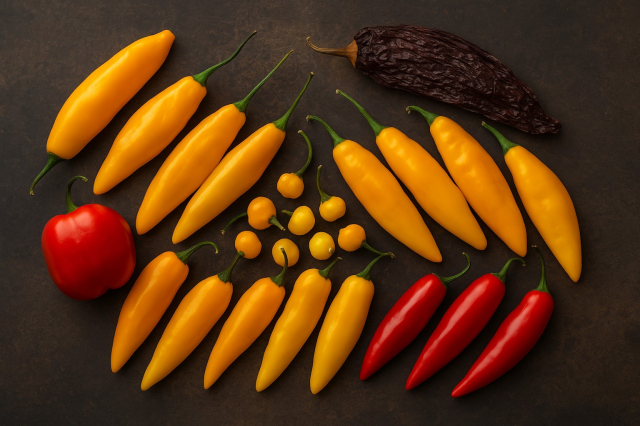In Peru, to speak of chili peppers is to speak of identity. This fruit, which has been a part of Peruvian cuisine since pre-Columbian times, provides more than just heat: it's the soul of Creole flavor, the color of stews, and the secret behind most of our traditional dishes. Its presence on the table is so essential that, without chili peppers, Peruvian cuisine simply wouldn't be the same.
Origin and history of chili peppers in Peru
Chili peppers are among the oldest domesticated plants in the Americas. In Peru, their cultivation dates back more than 6,000 years, with archaeological evidence at Caral, Huaca Prieta, and along the northern coast. The ancient Peruvians used them not only as a condiment but also as a preservative and natural medicine.
During the pre-Incan era, chili peppers were a symbol of culinary power. In the Inca Empire, they were part of the daily diet along with corn and potatoes. Spanish chroniclers, such as Bernabé Cobo, were surprised by the intensity of their flavor and by the number of varieties that existed in Peru.
📖 If you are interested in the origins of Peruvian ingredients, we recommend you also read “Typical dishes for the end-of-year festivities in Peru” .
Main varieties of Peruvian chili peppers
Peru has over 50 documented types of chili peppers, each with a different flavor, color, and spiciness level. Below, we show you the most popular ones:
Yellow chili pepper
Common use: base of emblematic dishes such as papa a la huancaína, ají de gallina or causa limeña.
Flavor: medium spicy with fruity notes.
Fun fact: in its dried form it is known as mirasol chili.
Aji limo
Common use: indispensable in Peruvian ceviche.
Flavor: intense spiciness and citrus aroma.
Colors: can be red, yellow or even purple depending on the variety.
Ají panca
Common uses: meats, anticuchos, marinades and stews.
Flavor: smoky, sweet and mildly spicy.
Form: It is mainly used dry or as a paste.
Rocoto
Common use: the famous Arequipa-style stuffed rocoto pepper.
Taste: extremely spicy, with a sweet touch.
Origin: native to the southern Andes; it is cultivated in Arequipa, Ayacucho and Cusco.
Charapita chili pepper
Common uses: Amazonian dishes and regional sauces.
Flavor: small but intensely spicy.
Special feature: it is considered a gastronomic jewel of eastern Peru.
Chili peppers as a cultural symbol
Chili peppers not only spice up, they also represent something. In Peruvian popular culture, saying someone “has chili” means they have character or energy. In many regions of the country, chili peppers are part of the collective identity and local celebrations.
During food fairs or patron saint festivals, communities showcase their best spicy dishes as a source of regional pride. For example, at the Rocoto Festival in Arequipa or the Chili Pepper and Fish Fair in Piura, this fruit is celebrated as a national treasure.
You can also explore our article on “Peruvian Food Festivals” to find out where these flavors are celebrated.
Secrets to cooking with Peruvian chili peppers
Balance: not all dishes need to be spicy. Chili peppers are also used for their aroma and color.
Preparation: blanched or deveined chili peppers reduce their spiciness without losing flavor.
Storage: You can freeze the chili paste in small portions for use throughout the year.
Combination: the yellow chili pepper and the panca pepper together create an ideal base for Creole stews.
Pairing: Chili peppers go well with citrus fruits, fish, and red meat.
Chili peppers in modern gastronomy
Today, Peruvian chefs like Gastón Acurio and Virgilio Martínez have revitalized the ají pepper as a flagship product of Peru. Thanks to their innovative cuisine, its varieties have been incorporated into gourmet dishes, cocktails, and even desserts, winning over international palates.
Peruvian chili peppers are exported to more than 40 countries, and their paste has become a key product for Peruvian restaurants abroad. Furthermore, agricultural initiatives are promoting their sustainable cultivation in Andean and Amazonian regions.
An ingredient that unites Peru
More than just a condiment, chili peppers are a symbol of diversity and unity. From Lima-style ceviche to Amazonian tacacho or Arequipa-style chupe, each region of Peru has its own type of chili pepper, but the love for its flavor is shared throughout the country.
Thus, chili peppers continue to be the spicy thread that connects our history, our traditions, and our gastronomic identity.
